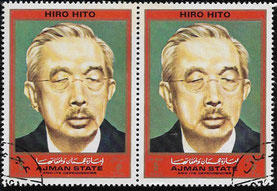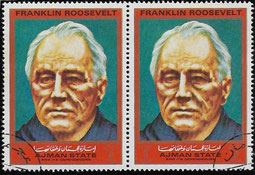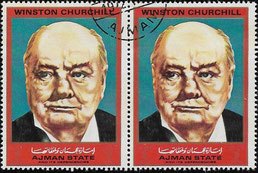Great Men Of The War

On March 31, 1972, Ajman issued a set of stamps with theme "Great men of the war”, that is World War II.
One can interpret this in 2 ways. Either is "great" in this context "significant" in the sense of the role played by the person, or one actually means an
"admiration". Now, in addition to Roosevelt, Churchill and De Gaulle, the stamp set includes such illustrious individuals as Stalin, Franco, Mussolini and Hirohito. A stamp for Hitler was also
prepared, but was not issued; here, the "red line" was drawn. From Ajman's point of view, both the interpretation of "great" and the persons represented in the stamp series were probably
irrelevant, since the sole aim was commercial success with stamp collectors. Also, as far as the positive or negative historical significance of the persons shown was concerned, Ajman or the
corresponding producing agency, which produced the stamps on behalf of Ajman, probably had few reservations. In the sense of the chosen theme for the stamps, it is logical to speak of "war",
since Franco was not "active" in World War II, but had "his" war from 1936-1939 in the Spanish Civil War. Also Japan's and therefore Hirohito's (2nd World) War began in 1931 with the invasion of
China. Japan entered the "official" World War II in 1941 with the attack on Pearl Harbor.

That Hitler (1889-1945) did not receive stamp honours is certainly no surprise. The majority of the stamps of the set were allegedly shipped to New
York to be placed in stamp packages. As part of this process, the Hitler stamps were sorted out and apparently destroyed. In world history, it is a unique event that mass murder (Holocaust), in
the sense of genocide, of Jews as well as Sinti/Roma in Nazi Germany was carried out with "industrial" procedure and "mass dispatch" in the form of gasification. Not to forget the mass shootings,
torture, labor exploitation, concentration camps, ghettoization. Organisations like SS, SD, police, Gestapo, parts of Wehmacht, local helpers and others had their share in it. In this sense,
Hitler's Nazi regime was an instrument of terror directed against large parts of Europe. Affected were also political dissidents, disabled, homosexuals, religious groups, prisoners of war and
others.
While Hitler stamps during the Nazi era are abundant, it is not surprising that official stamps depicting Hitler after World War II are known only in one case. It
is a mini sheet of Mongolia from 2001 on the theme "Events of the 20th century". On one of the stamps Hitler and Mussolini are depicted with the theme "Seizure of Power". So, in context, this is
not about Hitler himself but about an, for Germany and the world, incisive event that it undoubtedly was. It is unfortunate that the Swastika emblem can also be seen as an armband, although this
was of course "the" emblem of Hitler's Germany to the outside world. Furthermore, there are cinderellas with Hitler depictions that look like official stamps of African postal administrations,
mostly with face value and country designation, but are definitely not commissioned or authorised by the postal administrations concerned. Man postal administrations, on the other hand, have
dedicated official stamps to the victims and events of Nazi terror and the Holocaust over the decades after World War II.
Hitler
Resistance
Event
Hitler's henchmen
Attempted Hitler Assassination
Massacre

An interesting case is Stalin (1878-1953). His dictatorship in the Soviet Union is also characterised by mass murder, assassination, torture, expulsion with genocidal features, starvation. At Stalin's rule millions of deaths were recorded, exact numbers are unknown or disputed until today. Two of the most drastic events in terms of death scenarios are, on the one hand, the expropriation, forced collectivisation and industrialisation in the early 1930s and, on the other hand, the purge waves in the years 1936-38. Stalin's primary pursuit was his own preservation of power. His "recipe for success" was based on terror and fear. He was never "popular" as Hitler was, at least until the first years of the war. No one could be sure that he would not be one of Stalin's victims. So there were no other rulers besides Stalin, not even in the highest body, the Politburo, which in the second half of his dictatorship consisted only of “Yes”-men. But this was by no means a life insurance policy. Stalin repeatedly got rid of what he saw as "dangerous" rivals. His striving to maintain power had paranoid features. Even his instrument of terror, the secret service (operating under his aegis under the names Cheka, then OGPU, then NKVD) was not safe from Stalin's grasp. Its chiefs became victims of Stalin as well as other employees (or criminals) of this organisation, who terrorised their own population as well as neighbouring states on Stalin's behalf.
Moreover, the terror in the Soviet Union was directed inward (there were exceptions, e.g. the Katyn mass execution), while Hitler's terror affected large parts of Eastern Europe and also, especially as far as Jewish populations were concerned, Western Europe. In the Soviet Union, there was a "de-Stalinisation" after Stalin's death, which, however, clearly lagged behind the denazification in Germany, even the latter being carried out less than half-heartedly. This cannot be surprising, because the top leadership after Stalin was itself largely part of the "Stalin" system with all its consequences.
If one wanted to characterise Stalin with one sentence, this would be fitting: "No one has killed more communists than Stalin".
In philatelic terms, one can find stamps on Stalin after his death in communist countries, for example on the 100th birthday of the dictator. But also, very similar
to the set of stamps of Ajman, with Grenada in 2015 a set of stamps, again purely for commercial reasons (for the Chinese collector market) under the motto "Leaders of the 2nd World War".
Likewise with Togo. But Stalin can also be found on personalised stamps, even in Germany. Likewise, there are some cinderellas. On the other hand, there is only one stamp (from Poland) dedicated
to "all" victims of Stalin's terror, at least on the stamp it says so, no restriction is made. Again, specific commemorative stamps on Stalin victims are issued periodically from Poland on the
Katyn massacre and also a stamp from Latvia on deportations or an Ukraine stamp on an individual person. Nothing of the sort is found for the USSR and Russia.
The situation is different with the terror instrument Cheka/OGPU/NKVD. In the USSR/Russia there were and are 2 stamps dedicated to its 50th and 100th anniversary.
In addition, both in Russia and other countries, eg Armenia there are stamps dedicated to members or leaders of this organisation. Also a vignette exists for the 100th anniversary with all the
chiefs in this period, including the 5 in the Stalin era, who were , along with Stalin, mainly responsible for the terror against the Soviet population.
An essential difference to Hitler's dictatorship is that the crimes in Soviet Russia took place largely "unnoticed" by the rest of the world. Stalin "hermetically"
isolated the Soviet Union. And even if crimes became known, this did not cause any problems for Stalin, because he was needed in the West as a front against Hitler (especially in World War
II).

Mussolini (1883-1945) was officially Prime Minister of the Kingdom of Italy from 1922-1945, from 1925 in fact its fascist dictator, also called
"Duce" (leader).
In the "pacification of Libya”, Mussolini sent troops in 1923, by 1933, 80,000 locals had been killed.
The Abyssinian War (1935/36), which ended with a reign of violence by Italy in Abyssinia (today Ethiopia), was waged by the attacking Italy, also with massive use
of chemical warfare agents and an intensive air war, in a hitherto unknown manner with extreme brutality. Between 360,000 and 720,000 Abyssinians lost their lives. None of the Italian war
criminals were ever brought to justice. Italy then practiced in the formed Italian East Africa (which included, besides Abyssinia, the already existing colonies of Eritrea and Italian Somaliland)
a policy called "apartheid racism".
From 1937, Mussolini began to seek close contact with Hitler, with whom he formed a military alliance in 1939. On June 10, 1940, Italy entered World War II
alongside Hitler. Italian offensives failed and Italy lost the ability to wage war independently. Italy also provided troops for Hitler's eastern campaign.
In 1943, Mussolini was arrested by opposition fascists and monarchists due to internal tensions. On Hitler's initiative, he was freed and stood as Hitler's puppet
at the head of the “remainder” of Italy for 2 years. At the end of the war, Mussolini was arrested by partisans and executed.
Philatelically, Mussolini is found mainly at Hitler's side on Italian stamps, as well as on stamps of the Italian colonies; a Third Reich stamp also shows both of
them. After the end of the war, Mussolini can be seen, besides the Ajman stamp, only on the Mongolian miniature sheet (see above). There are cinderellas existing also.

One person who is at least ambivalent is the former emperor of Japan, Hirohito (1901-1989). As emperor, Hirohito was the head of state of Japan
from 1926-1989. After World War II and as a consequence of Japan's defeat, Hirohito's role was reduced to a purely representative function. An impeachment due to his co-responsibility for
Japanese war crimes in World War II did not take place. As for Japan, the 2nd World War began with the invasion of China by Japanese troops in 1931. Japanese troops committed numerous war crimes
on Chinese soil, culminating in the Nanking Massacre in 1937. Hirohito, as head of state, was responsible. Moreover, he also contributed indirectly, as there
was a decree by Hirohito that no prisoners should be taken. War crimes and targeted killings were also committed in the Pacific region, Southeast Asia and Indonesia. In total, several million
civilians and prisoners of war fell victim to this so-called "Asian Holocaust."
A reappraisal of Japanese war crimes and Hirohito's role in them was never really done in Japan. To this day, these events continue to strain Japanese-Chinese
relations, as well as Japan's relations with Korea.
Philatelically, Hirohito naturally appears on Japanese stamps. Otherwise, Hirohito can be found sporadically on African stamps. As for commemorations of victims of
Japanese war crimes, there are Chinese stamps dedicated to such monuments.

With the military coup in 1936 under Franco's leadership, the 3-year Spanish Civil War began with 200,000 to 500,000 dead. On Franco's side, the
main aids were Hitler with the "Condor Legion" and Mussolini with a large military contingent. On the side of the Republicans, overthrown by the military coup, mainly the communist-influenced
International Brigades were involved. One of the sad highlights of the civil war was the devastating bombing of the city of Guernica by the participating German and Italian air forces, an event
that Pablo Picasso already thematised in 1937 in his large and famous painting "Guernica".
In the years that followed the Spanish Civil War, Franco was primarily interested in consolidating his dictatorship, in the course of which hundreds of thousands
were executed and around 1.5 million political prisoners were held, many in 190 concentration camps around Spain. Franco owed the external survival of his fascist dictatorship after World War II
primarily to the fact that he kept Spain in neutrality and did not enter the war on the side of the Axis powers.
Franco's dictatorship lasted until his death in 1975. In 1959, a monument was erected in the "Valley of the Fallen" to the fallen of the Spanish Civil War. In the
shrine next to it lie the bones of 30,000 fallen. Franco's bones, which also rested there, were removed in 2019 and transferred to another location.
Stamps of Franco in the time of his dictatorship exist, of course, outside of Spain there is only one stamp related to the visit of the Paraguayan dictator
Stroessner to Spain in the 1970s.
Stamps commemorating victims or opposition to Franco are few, in Spain only a 1959 stamp to the monument in the Valley of the Fallen. Otherwise from CSSR and GDR
and other communist countries commemorations of the International Brigades.
The other stamps of the Ajman set
Withdrawn, controversial and exceptional stamps and other withdrawn postally issued items
| * | = | Withdrawn |
|---|---|---|
| ** | = | Controversial |
| *** | = | Exceptional |
| **** | = | Unclear |
Diese Webseite wurde mit Jimdo erstellt! Jetzt kostenlos registrieren auf https://de.jimdo.com




